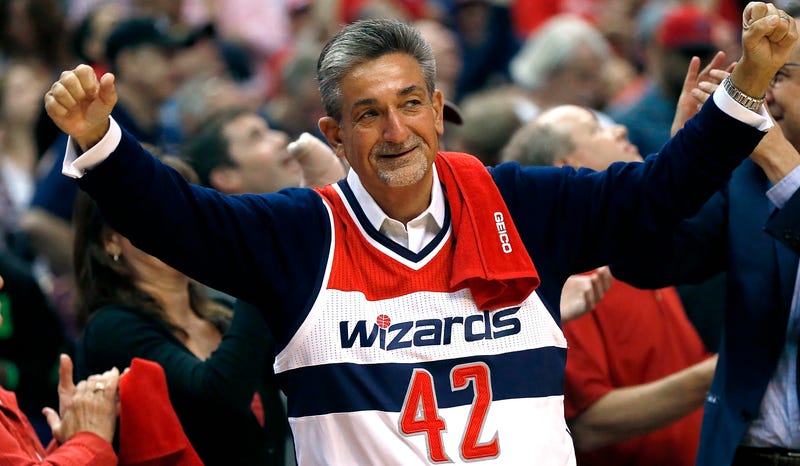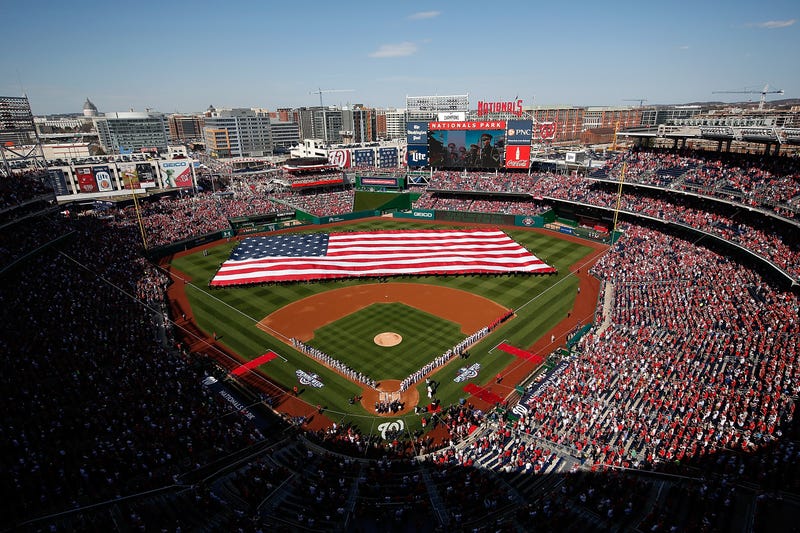
On February 18, construction crews began knocking down sections of St. Elizabeth’s, the Washington, D.C. psychiatric hospital famous for having housed, among others, John Hinckley, Josh Gibson. and the Shotgun Stalker. Mayor Muriel Bowser got in an excavator to kick off the demolition of Buildings #124 and #119 on the federally-owned campus, which opened in 1855 as the Government Hospital for the Insane. They had to disappear to make room for a practice facility for the Washington Wizards.
The redevelopment will cost $55 million, according to Bowser, with the D.C. government and Events DC—a taxpayer-funded para-governmental organization charged with cheerleading for all sports construction proposals—picking up the first $50 million of the project’s tab. How much of the remnant team owner Ted Leonsis is picking up is something of an unknown. Bowser has claimed that Leonsis will pay “up to $5 million” of the construction costs. The 73-page contract that Bowser presented to the city council a day after the groundbreaking, though, suggests that if and when Leonsis’s team moves into the facility, it will owe close to $4.5 million in rent and get $3 million in credit which, if not spent, can be used to offset the rent expense. Either way, the team’s contribution seems ceremonial.
The St. Elizabeth’s construction comes during an astounding binge of publicly-subsidized sports buildings proposed for the nation’s capital. On the same day when the mayor oversaw the groundbreaking for the Wizards practice space, Events DC head Greg O’Dell testified at a sparsely attended oversight hearing held in the city council chamber that $160 million was earmarked for improvements and repairs to Nationals Park. That’s the baseball stadium which was built almost entirely with public money and opened in 2008. The city is also building a $300 million soccer stadium for DC United of MLS with taxpayer funds.
These projects, costly as they are, will likely end up looking like mere appetizers for what promises to be a whopper of a boondoggle: a new home for the Washington Redskins. Bowser and some members of the city council have been actively courting the team to come back to the city and are dangling the possibility that the site where RFK Stadium now sits would make a fine home. The team enjoyed its greatest glories on those grounds before leaving for godforsaken Landover, Md. after the 1996 season. Skins owner Dan Snyder has already announced that the Bjarke Ingels Group, a Danish architectural firm, will design the team’s next home, but has otherwise coyly stayed quiet about where it will be or who will pay for it. He’s apparently content to let the D.C. mayor joust with pols in Maryland and Virginia over who is best suited to give Snyder, who just a few years ago bought himself a $70 million boat, boatloads of public money.
A golden age, of sorts
“It’s sick,” says Ralph Nader, who has been a D.C. resident throughout his half-century-plus of high-profile rabble-rousing. He was the first person I thought of when I realized the city government had taken on a No Billionaire Left Behind agenda with proprietors of professional sports teams in the area. For all his vanity candidacies and noble consumer advocacies, Nader, who turned 82 over the weekend, has never gotten proper credit for being a pioneer in the fight against spending the people’s money on sports venues.
On the whole, D.C. is enjoying something of a golden age. The fruits of our nation’s real and unreal wars are visible nowhere so much as in the capital. There’s so much money coming into D.C. these days that it’s possible to fund all the corruption that’s always been a staple of the city government and still get things done. Parks and playgrounds and schools all over town have been transformed from shabby to state-of-the-art in recent years.
One example of money being righteously spent: In February 2007, I went to Roosevelt High School in the Petworth neighborhood to watch the basketball team play rival Cardozo High for a story. When I walked through the school’s front entrance, water dripped from the ceiling onto my head. On my walk to the gym I saw sections of ceiling missing there and throughout the hallway from non-recent water damage, and students’ lockers that had been torn out or rusted to the point of unusability. The place looked altogether like it should have been condemned. Cardozo was listed as the home team, but had no real home games because their gym had been condemned.
At the time of my visit to Roosevelt, the city was in the process of providing $670.3 million of the $701.3 million total cost to build Nationals Park for Washington Nationals owner Ted Lerner, and had just gifted another $50 million to then-Wizards owner Abe Pollin to spruce up the luxury boxes and install a new scoreboard at his downtown arena. Both Lerner and Pollin were Roosevelt High alums, but hadn’t ever done anything to stem the decomposition of their alma mater.

Fast forward to 2016: Roosevelt is now nearing the end of a $136 million-plus renovation that will give it huge glass-covered atriums and a palatial new main entrance. In 2013, Cardozo reopened after its own $130 million rehab, with, yes, its own gymnasium.
Using tax money during this prosperous era to benefit students is one thing. The folks who profit most from the city’s sports-centric largesse, however, are very, very wealthy.
“Pretty soon it’ll be professional badminton.”
Those who keep track of such things put the net worth of Ted Leonsis, who owns the Washington Capitals and bought the Wizards and the Verizon Center when former owner Pollin died in 2009, at $1 billion. DC United’s ownership group, meanwhile, is led by Eric Thohir, an Indonesian media mogul and the son of a billionaire coal baron. Thohir owns several professional sports teams, including Inter, one of the flagship clubs of Serie A, the premier Italian soccer league. Last year, Forbes declared Ted Lerner “Major League Baseball’s richest owner,” and now says he’s worth $5.7 billion. That same publication put the personal wealth of Skins owner Snyder at $2.1 billion.
Nader has had some wins in his campaigns against corporate welfare. In 1998, after the New England Patriots announced the team was leaving Foxboro, Mass. and moving to his native Connecticut, Nader got involved. He filed a lawsuit to get Connecticut governor John Rowland to break a promise to owner Robert Kraft to build a $374 million stadium in Hartford with public funds. “This stadium will never be built,’’ he told the New York Times. Rowland initially attacked Nader as a troublemaking carpetbagger, then watched as the Nader-led opposition gained traction. Kraft then put his hand out back home and got Massachusetts to give him $70 million for a stadium, the Pats stayed put, and Connecticut residents had a few hundred million to spend elsewhere. Gov. Rowland soon after resigned from office and went to prison for unrelated federal corruption charges.
Off his Connecticut effort, Nader formed a non-profit, League of Fans, to advocate against stadiums built with the public’s money in 2001, not long after the most momentous of his many unsuccessful runs for president. He made the crusade against public subsidies for sports owners a cornerstone of his failed 2004 presidential campaign, railing against the proposed stadium in DC for the Washington Nationals while on the trail. The last event of his campaign was held at a run-down branch of the D.C. Public Library, at the time among the worst systems in the country, to make the point that tax money should be spent on things other than buildings for billionaires.
“The stadium’s not going to happen,” Nader told me at the time.
League of Fans was successful in getting stadium proposals on the ballot in several states. On Election Day 2004, Nader got less than one percent of the popular vote in the presidential race, but just as League of Fans had advocated, voters shot down stadium projects in San Francisco, Kansas City, and St. Louis.
Things didn’t go so well in his hometown. His group failed to get the D.C. stadium proposal put to a vote, and Nationals Park, as we know, was indeed built, and almost entirely with public money.
“That would not have survived a referendum,” he tells me now. “No way. That’s why politicians work so hard to keep these things off the ballot.”
He seems awed that practice facilities are now considered suitable handouts for sports owners, and wistful for the days when all he had to do was fight against baseball and football stadiums.
“Now it’s soccer?” he says. “Pretty soon it’ll be professional badminton. We’re dealing with the decline of the American empire. In the final throes of a dying empire, they resort to entertainment and circuses to divert the masses. And that’s what we have here.”
But Nader still seems ready to lead sports venue fights, here and all over. “If you get 1000 people who’d devote as much time to this as they would any hobby, and a few folks for full time staff,” he says, “we could stop all of this.”
Ted Leonsis did not respond to requests for comment for this story. A week after the groundbreaking on their gifted practice facility, the Wizards announced ticket prices would be raised for the third year in a row.
Know something we should know? Contact the author at dave.mckenna@deadspin.com.



